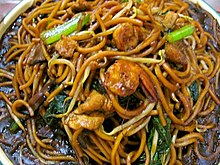Chow mein
| Chow mein | |||||||||||||||||||||||
 |
|||||||||||||||||||||||
| Traditional Chinese | 炒麵 | ||||||||||||||||||||||
|---|---|---|---|---|---|---|---|---|---|---|---|---|---|---|---|---|---|---|---|---|---|---|---|
| Simplified Chinese | 炒面 | ||||||||||||||||||||||
| Literal meaning | "Stir-fried noodles" | ||||||||||||||||||||||
|
|||||||||||||||||||||||
| Transcriptions | |
|---|---|
| Standard Mandarin | |
| Hanyu Pinyin | chǎo miàn |
| IPA | [ʈʂʰàumjɛ̂n] |
| Hakka | |
| Romanization | cau mien |
| Yue: Cantonese | |
| Yale Romanization | cháau mihn |
| Jyutping | caau2 min6 |
| Southern Min | |
| Hokkien POJ | chhá-mī |
Chow mein (/ˈtʃaʊ ˈmeɪn/) are stir-fried noodles, the name being the romanization of the Taishanese chāu-mèing. The dish is popular throughout the Chinese diaspora and appears on the menus of Chinese restaurants. It is particularly popular in Pakistan, the United States, Britain, Nepal, and India.
The word means 'fried noodles', chow meaning 'fried' and mein meaning 'noodles'. The pronunciation chow mein is an English corruption of the Taishanese pronunciation chāu-mèing. The lightly pronounced Taishanese [ŋ], resembling the end of a Portuguese nasal vowel, was taken to be /n/ by English speakers. The Taishan dialect was spoken by migrants to North America from Taishan.
In American Chinese cuisine, it is a stir-fried dish consisting of noodles, meat (chicken being most common but pork, beef, shrimp or tofu sometimes being substituted), onions and celery. It is often served as a specific dish at westernized Chinese restaurants. Vegetarian or vegan Chow Mein is also common.
There are two main kinds of chow meins available on the market:
...
Wikipedia
